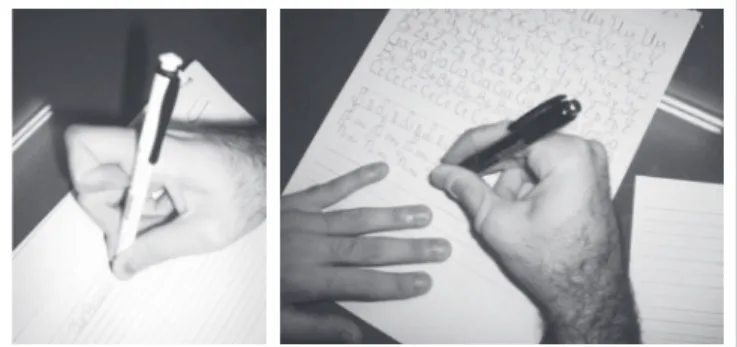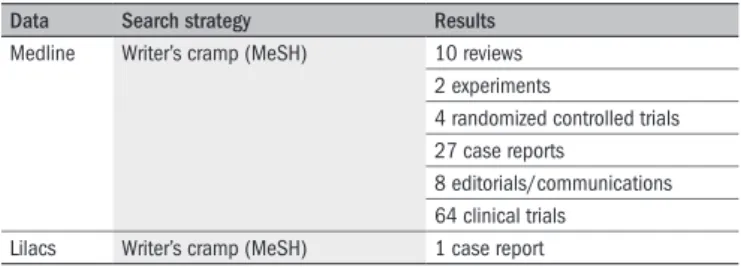Sao Paulo Med J. 2010; 128(2):96-8
96
Case report
A new therapeutic proposal for writer’s cramp: a case report
Nova proposta terapêutica para a câimbra do escrivão: relato de caso
Flavia Quadros Boisson Waissman
I, João Santos Pereira
II, Osvaldo José Moreira Nascimento
IIIMovement Disorders Section, Department of Neurology, Pedro Ernesto University Hospital, Universidade do Estado do Rio de Janeiro (UERJ), Rio de Janeiro, and Department of Neurology, Universidade Federal Fluminense (UFF), Niterói, Rio de Janeiro, Brazil
IMSc. Physiotherapist, Department of Neurology, Universidade Federal Fluminense (UFF), Niterói, Rio de Janeiro, Brazil.
IIMD, PhD. Adjunct professor of Neurology, Head of Movement Disorders Section, Department of Neurology, Pedro Ernesto University Hospital, Universidade do Estado do Rio de
Janeiro (UERJ), Rio de Janeiro, Brazil.
IIIMD, PhD. Titular professor of Neurology, Department of Neurology, Universidade Federal Fluminense (UFF), Niterói, Rio de Janeiro, Brazil.
ABSTRACT
CONTEXT: Writer’s cramp is a kind of focal hand dystonia that appears when individuals are writing. Since pharmacological treatment has not shown the desired therapeutic response, a study on immobilization of the damaged musculature was performed on two individuals with writer’s cramp, using splints with the objective of reducing the handwriting abnormalities.
CASE REPORT: Two patients presenting writer’s cramp who had previously undergone different therapies, including botulinum toxin, without an adequate response, participated in a body awareness program, followed by immobilization of the hand musculature damaged by dystonia, by means of splints, with handwriting training. At the end of the procedure, objective and subjective improvements in the motor pattern of writing could be observed. The immobilization of the dystonic musculature of the hand by means of splints and the motor training of handwriting helped to improve and consequently to reduce the dystonic component observed in the writer’s cramp.
RESUMO
CONTEXTO: A câimbra do escrivão é um tipo de distonia focal da mão que aparece quando a pessoa escreve. Como o tratamento farmacológico não tem mostrado a resposta terapêutica almejada, um estudo sobre a imobilização da musculatura comprometida foi feito em dois indivíduos com câimbra do escrivão, utilizando órteses com o objetivo de reduzir as alterações da escrita.
RELATO DE CASO: Dois pacientes apresentando câimbra do escrivão que haviam sido submetidos previamente a terapêuticas, inclusive toxina botulínica, sem resposta adequada, participaram de um programa de consciência corporal, seguido de imobilização por órteses da musculatura da mão comprometida pela distonia, com treinamento da escrita. Ao término, evidenciaram melhora objetiva e subjetiva no padrão motor da escrita. A imobilização por órteses da musculatura distônica da mão e o treinamento motor da escrita favorecem a melhora e, consequentemente, a redução do componente distônico observado na câimbra do escrivão.
KEY WORDS:
Writer’s cramp. Focal dystonia. Dystonic disorders. Movement disorders. Handwriting.
PALAVRAS-CHAVE:
A new therapeutic proposal for writer’s cramp: a case report
Sao Paulo Med J. 2010; 128(2):96-8
97
INTRODUCTION
Writer’s cramp is shown by involuntary muscle contractions in the arm or hand while writing. Compression, paper destruction, pain and diiculty in holding a pen may occur. he abnormality of sensory-mo-tor integration may be due to impairment of aferent activityand a sen-sory-motor training program can modify this disorder.1
he efects of the use of splints in the cases of two patients with writer’s cramp were investigated.
CASE REPORT
Two patients with diagnoses of writer’s cramp (one male and one female) were accepted for evaluation. he institution’s Ethics Commit-tee approved this study and the patients signed a free and informed con-sent statement.
he irst patient, a right-handed 24-year-old white male, had pre-sented diiculty in writing for six years, followed by intense pain in the thenar region, seconds after beginning the task. he second patient, a right-handed 44-year-old white female, had presented diiculty in writ-ing for 28 years, followed by pain and fatigue in her forearm and hand, plus extension and radial deviation of the wrist.
Functional motor evaluation was performed on the hand using the Burke-Fahn-Marsden scale (BFMS) and Jedynak’s protocol, and an an-alog pain scale.2 he rehabilitation training was administered over an
eight-week period, in two phases of four weeks each, twice a week for 60 minutes each session. During the irst phase, body awareness training using relaxation techniques was administered. During the second phase, appropriate splints were used on the afected musculature of the in-gers, in order to inhibit dystonic action. Similar exercises at home were scheduled for 30 minutes a day.
For the irst patient, the functional motor examination showed dystonic postures of the hand and forearm during writing, with in-dex inger and thumb extension, wrist lexion and excessive pressure used to hold the pen. he Jedynak score for writing quality was two. Using the BFMS, the scores for the dystonic efect and for handwrit-ing were both two. A few seconds after beginnhandwrit-ing to write, a pain in the ingers and thenar region appeared, which were scored as three and ten, respectively.
After the rehabilitation, dystonic posture and excessive pressure were no longer found, thus showing better motor control. Although there was an improvement, the handwriting still presented occasional irregularities, and was scored as one, on the Jedynak protocol. he score for the functional motor characteristics evaluated by BFMS was zero and for writing disability, one (Figure 1). he pain in the ingers and th-enar region while writing were scored as one and eight, respectively.
he second patient showed forearm pronation, lexion and radial deviation of the right wrist, lexion with overlapping of the index inger in relation to the thumb, and excessive grip on the pen and pressure on the paper. he pain in the ingers and thenar region was scored as three and ten, respectively. he writing quality was three. From the BFMS, the score for dystonic movement of the arm region was six and for writ-ing disability, two.
he forearm pronation and dystonic ingers showed great improve-ment. he gripping of the pen and pressure on the paper were greatly decreased. he quality of handwriting was scored as one using the Je-dynak protocol. From the BFMS, the score for dystonic movement was four and for writing disability, one (Figure 2). he pain in the ingers and thenar region was scored as zero and nine, respectively. Subjectively, there was a 30% to 40% improvement in the writing process.
DISCUSSION
In our study, the body awareness training had the result that com-pensatory maneuvers no longer occurred after the training period. hese observations resemble the results from body reeducation among musi-cians with focal hand dystonia.3
In both patients studied, reductions in pain and improvements in handwriting quality, character formation and pressure on the paper oc-curred, comparing the situations before and after the program.
hese patients with writer’s cramp maintained the 30 to 50% im-provement in their symptoms after the removal of the immobilization splints. Another study found that 50% of the patients maintained a marked improvement.4 Our indings, although preliminary, showed
slight to moderate improvement.
Although another report described worsening of writing after dai-ly practice was discontinued, the beneits acquired during this training with splints can be maintained for six months.4 Studies using a larger
sample would be necessary, although these results are not far from those
Figure 1. Dystonic posture of foreinger before the sensory-motor training (left) and the improvement following the program (right). This posture was maintained without the splint.
Sao Paulo Med J. 2010; 128(2):96-8 Waissman FQB, Pereira JS, Nascimento OJM
98
Table 1. Total numbers of papers indexed by Lilacs (Literatura Latino-Americana e do Caribe em Ciências da Saúde), Embase (Excerpta Medica), Medline and the Cochrane Library, with regard to the term “writer’s cramp” (1998 to 2008)
Data Search strategy Results
Medline Writer’s cramp (MeSH) 10 reviews 2 experiments
4 randomized controlled trials 27 case reports
8 editorials/communications 64 clinical trials
Lilacs Writer’s cramp (MeSH) 1 case report
Medline = Medical Literature Analysis and Retrieval System Online; MeSH = Medical Subject Headings.
observed with the use of botulinum toxin, which produced satisfactory results in 50% to 70% of the cases and only 16.4% of those patients used oral medication.5
Considering the results from our investigation, and because of the major diiculty in diagnosing and providing therapy for this neuro-logical disorder, we carried out a systematic analysis of the indexed articles published since 1998, in order to provide a better foundation for our study. We searched using the term “writer’s cramp” in the Li-lacs (Literatura Latino-Americana e do Caribe em Ciências da Saúde), Embase (Excerpta Medica Database), Medline and Cochrane Library databases, using DeCS (Descritores em Ciências da Saúde) and MeSH (Medical Subject Headings). Of the 715 references found in Medline alone, 115 really referred to writer’s cramp or focal hand dystonia in their titles. In Lilacs, out of seven papers, only one paper related to the subject6 (Table 1).
Among these papers, there were six studies7-12 using botulinum
tox-in A, with diferent results. In relation to spltox-int immobilization, the same number of studies was found1,4,13-16 and two of these were
pro-spective studies1,13 Most of the studies related to diagnostic methods or
functional tests. It could be seen that this rehabilitative procedure is very rarely used. his may be because it is unknown to some health profes-sionals, or even because of diiculty in adherence to treatment among the patients.
CONCLUSION
he therapeutic response to noninvasive treatment for writer’s cramp is eicient with regard to writing quality, morphofunctional character-istics and manual ability.
REFERENCES
1. Zeuner KE, Shill HA, Sohn YH, Molloy FM, Thornton BC, DambrosiaJM, Hallett M. Motor trai-ning as treatment in focal hand dystonia. Mov Disord. 2005;20(3):335-41.
2. Jedynak PC, Tranchant C, de Beyl DZ. Prospective clinical study of writer’s cramp. Mov Disord. 2001;16(3):494-9.
3. Chamagne P. Functional dystonia in musicians: rehabilitation. Hand Clin. 2003;19(2):309-16. 4. Priori A, Presenti A, Cappellari A, Scarlato G, Barbieri S. Limb immobilization for the
treat-ment of focal occupational dystonia. Neurology. 2001;57(3): 405-9.
5. Das CP, Prabhakar S, Truong D. Clinical proile of various sub-types of writer’s cramp. Parkin-sonism Relat Disord. 2007;13(7): 421-4.
7. Tsui JK, Bhatt M, Calne S, Calne DB. Botulinum toxin in the treatment of writer’s cramp: A double-blind study. Neurology. 1993; 43(1): 183-5.
6. Urbina Luengo JC, Durán Robledo P. Distonía focal de la mano. Kinesiologia. 1999;56:78-9. 8. Ceballos-Baumann AO, Sheean G, Passingham RE, Marsden CD, Brooks DJ. Botulinum toxin does not reverse the cortical dysfunction associated with writer’s cramp. A PET study. Brain. 1997;120:571-82.
9. Karp BI. Botulinum toxin treatment of occupational and focal hand dystonia. Mov Disord. 2004; 19 (Suppl 8): S116-9.
10. Das CP, Dressler D, Hallett M. Botulinum toxin therapy of writer’s cramp. Eur J Neurol. 2006;13(Suppl 1):55-9.
11. Kruisdijk JJ, Koelman JH, Ongerboer de Visser BW, de Haan RJ, Speelman JD. Botulinum toxin for writer’s cramp: a randomized, placebo-controlled trial and 1-year follow-up. J Neurol Neurosurg Psychiatry. 2007;78(3):264-70.
12. Djebbari R, du Montcel ST, Sangla S, Vidal JS, Gallouedec G, Vidailhet M. Factors predicting improvement in motor disability in writer’s cramp treated with botulinum toxin. J Neurol Neurosurg Psychiatry. 2004;75(12):1688-91.
13. Zeuner KE, Peller M, Knutzen A, Hallett M, Deuschl G, Siebner HR. Motor re-training does not need to be task speciic to improve writer’s cramp. Mov Disord 2008;23(16): 2319-27. 14. Koller WC, Vetere-Overield B. Usefulness of a writing aid in writer’s cramp. Neurology.
1989;39(1): 149-50.
15. Chaná-Cuevas P, Kunstmann-Rioseco C, Rodríguez-Riquelme T. Distonía del guitarrista: tratamiento com reeducación sensorial. [Guitarist’s cramp: management with sensory re-education]. Rev Neurol. 2003;37(7):637-40.
16. Lanska DJ. Limb immobilization for the treatment of focal occupational dystonia. Neurology. 2002; 58(6):991.
Sources of funding: Not declared
Conlict of interest: Not declared
Date of irst submission: June 10, 2008
Last received: January 13, 2010
Accepted: January 14, 2010
Address for correspondence:
Flavia Quadros Boisson Waissman Rua Barão de Itambi, 14/302 Flamengo — Rio de Janeiro (RJ) — Brasil CEP 22231-000

